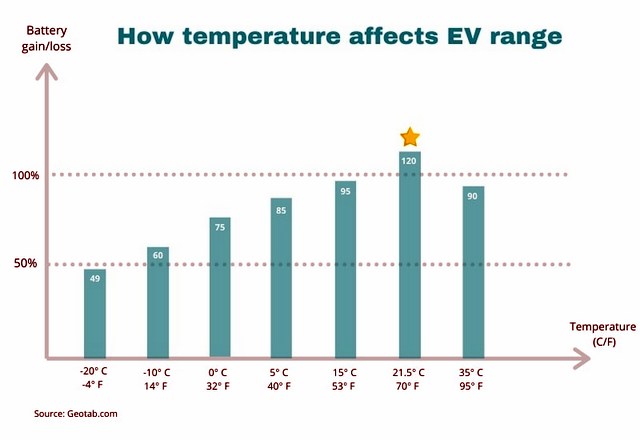Studies Show Loss of EV Range Depends on Temperature
Have you experienced a significant change in your EV range and wonder why that might be? Does the cold of winter and the heat of summer play a role in your battery’s life and efficiency?
Let’s shed some light on this topic and find out the answers to these questions.
According to Geotab, which has done a massive data download of more than 4,200 EVs with a combined 5.2 million miles, EVs can lose more than 40 percent of their battery performance during the cold of winter–a pretty staggering amount. The heat of summer negatively impacts the battery as well, although to a lesser extent.
Contrary to popular belief, this dramatic loss of battery performance is mostly due to the auxiliary heating or cooling of the vehicle and not because the low temperatures affect the battery that much.
What is the optimal temperature for maximum range?
The optimal temperature to reach the longest driving distance is 70o Fahrenheit (21.5o Celsius). While driving in such temperature, you can expect to go above the maximum range stated on your EV user manual by more than 20 percent with a brand new vehicle.
Geotab gathered data from more than a 100 different models/makes and year variations. The results showed that no matter the model, battery type or year of production, the range changes in a similar manner when it comes to driving in different temperatures.
Here is a chart to show the variations in range:

What are the main factors?
Now that you know how significant the range difference is depending on the weather condition, let’s see what the main factors are that contribute to that.
- Heating/cooling. During the winter, and respectively during the hot days of summer, heating and cooling use a lot of the battery power to keep the desired temperature in your car. During the winter, heating up the coupe can ‘eat’ more than 30 percent of the battery.
- Heated seats and steering wheel. To reduce the auxiliary load, many EVs have heated seats and steering wheels, which combined use from 30 to 70 watts to heat up your body through conduction, while heating the air in the cabin uses as much as 3000 watts, a significant difference.
- Defogging windows is another way to lose battery range.
- Battery degradation. Each year, your battery loses around 2.3 percent of its life on average. A five-year-old EV would have lost more than 10 percent of its life.
- Other factors to have in mind are your driving habits, the terrain, extra load, etc.
What can you do to reduce range loss
There are different ways to reduce range loss. Reducing auxiliary load is the most important as heating and AC use the most power; it is important to focus on those. As mentioned above, heating the air in the cabin is far less efficient than using the heated steering wheel and seats.
Another way to use less power for heating your car in the winter is to heat it up while it is still plugged in to your charger.
That goes for heating or cooling off the battery as well. In order to work optimally, an EV has built-in system that keeps the battery at optimal temperature to put out the most power. EV batteries are similar to humans when it comes to what temperatures they ‘like’. Anything below 40 or above 110 degrees Fahrenheit means part of the battery’s charge will be used to maintain its own temperature.
Related Stories You Might Enjoy—More Battery News
Interview: Batteries Are the Problem/Battery Management is the Solution
